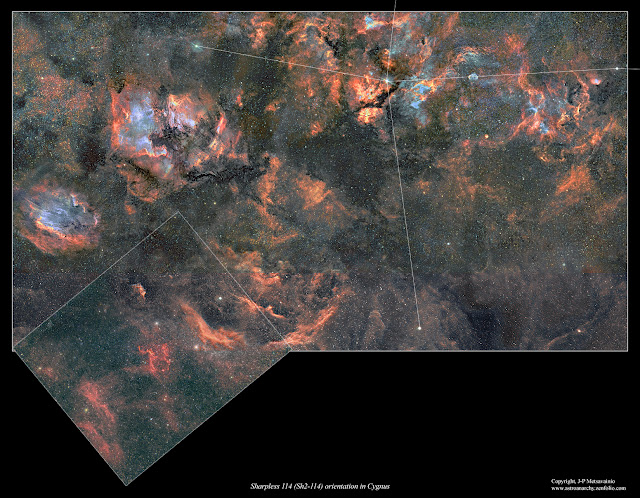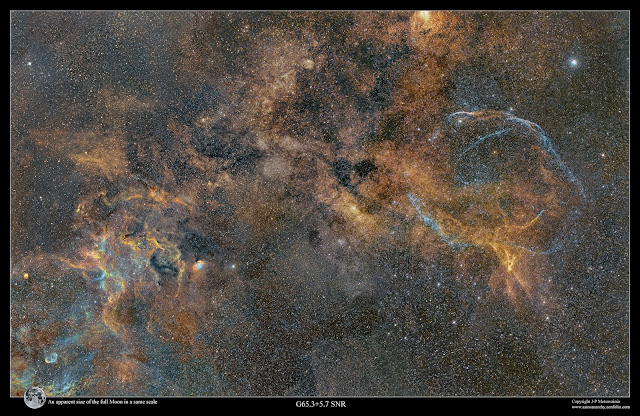COPYRIGHT, PLEASE NOTE
Thursday, December 31, 2020
All my photos from year 2020
The year 2020 has been interesting since I'm between the scopes at the moment. I converted my old Tokina At-x 300 mm f2.8 camera optics and paired it with the Apogee Alta U16 astro camera.
At first it looked like an impossible task since the back focus distance of Tokina lens was way too short for the camera. After some heavy handed modifications (including an angle grinder) I managed to marry those too junks of metal, glass and silicon together. Kind of Frankenstein's monster but worked!
After many years shooting with a long focal length instrument it was like a fresh air to work with wide field tool.
All my photos from the year 2020
Click for a full size poster (2000 x 2800 pixels)
Photo 11, https://astroanarchy.blogspot.com/2020/04/two-ways-to-go-in-same-field-of-view.html
Photo 12, https://astroanarchy.blogspot.com/2020/11/a-supernova-remnant-in-cygnus-g65357-snr.html
This SNR is part of the Cygnus mosaic (Image 21).
Photo 21, https://astroanarchy.blogspot.com/2020/01/deep-in-to-my-heart-ic-1805-in-mapped.html
https://astroanarchy.blogspot.com/2020/12/cygnus-project-grande-finale-for-now.html
Cassiopeia to Cepheus
https://astroanarchy.blogspot.com/2020/12/from-cassiopeia-to-cepheus-eight-years.html
- Sh2-124, https://astroanarchy.blogspot.com/2020/11/sharpless-124-sh2-124.html
- Sh2--124 wide field
- Clouds of Cassiopeia, https://astroanarchy.blogspot.com/2020/11/cassiopeia-mosaic-gets-larger.html
- SNR CTB1, https://astroanarchy.blogspot.com/2020/02/ctb1-supernova-remnant-in-cassiopeia.html
- Simeis 147, https://astroanarchy.blogspot.com/2020/03/the-birth-of-venus.html
- Tulip nebula area, https://astroanarchy.blogspot.com/2020/10/the-tulip-nebula-in-cygnus-sh2-101.html
- Sh2-205, https://astroanarchy.blogspot.com/2020/03/a-rare-image-sharpless-205-and-ngc-1491.html
- NGC 1499, https://astroanarchy.blogspot.com/2020/01/a-deep-view-to-california-nebula-in.html
- Sh2-132, https://astroanarchy.blogspot.com/2020/11/a-new-photo-of-sharpless-132-sh2-132.html
- Sh2-126, https://astroanarchy.blogspot.com/2020/10/new-photo-sharpless-126-in-lacerta.html
- Sh2-216 & 221, https://astroanarchy.blogspot.com/2020/04/two-ways-to-go-in-same-field-of-view.html
- SNR G65.3+5,7,https://astroanarchy.blogspot.com/2020/11/a-supernova-remnant-in-cygnus-g65357-snr.html
- IC 63 & NGC281, https://astroanarchy.blogspot.com/2020/03/ic-63-and-ngc-281.html
- SNR IC443, https://astroanarchy.blogspot.com/2020/03/supernova-remnant-ic-443-wide-field.html
- Bubble to Cave, https://astroanarchy.blogspot.com/2020/03/from-bubble-to-cave-nebula-area.html
- Cygnus, https://astroanarchy.blogspot.com/2020/12/cygnus-project-grande-finale-for-now.html
- Sh2-114, https://astroanarchy.blogspot.com/2020/12/sharpless-114-flying-dragon-nebula.html
- IC 405 & 410, https://astroanarchy.blogspot.com/2020/03/new-photo-deep-in-to-darkness.html
- Cederblad 214,https://astroanarchy.blogspot.com/2020/02/new-photo-of-cederblad-214-cosmic.html
- From CTB1 to Cave,https://astroanarchy.blogspot.com/2020/03/from-cassiopeia-to-cepheus.html
- IC 1805, https://astroanarchy.blogspot.com/2020/01/deep-in-to-my-heart-ic-1805-in-mapped.html
- IC 1396, https://astroanarchy.blogspot.com/2020/01/ic-1396-wide-field-reprocessed.html
- Cassiopeia to Cepheus, https://astroanarchy.blogspot.com/2020/12/from-cassiopeia-to-cepheus-eight-years.html
- Bubble to cave, https://astroanarchy.blogspot.com/2020/03/from-bubble-to-cave-round-ii.html
- Sh2-205 & LBN 696, https://astroanarchy.blogspot.com/2020/03/a-two-frame-mosaic-photo-of-sharpless.html
Sunday, December 27, 2020
From Cassiopeia to Cepheus, eight years and 300 hours of exposures
I started this imaging project back at 2012. During the years I have shot more frames for this active region of the sky. Now there are 26 panels and 22 high resolution sub-panels stitched together. Photo covers about 35 x 17 degrees of sky and the physical resolution is over 25.000 x 12.000 pixels. There are about 4,5 million individual stars visible in this image.
This is my second large mosaic image finalized in this month, a very large mosaic image of Cygnus can be seen here, https://astroanarchy.blogspot.com/2020/12/cygnus-project-grande-finale-for-now.html
A horizontal version
Click for a large image, it's really worth it! (1500 x 3000 pixels)
Orientation and size
Click for a large image
Info about the Cygnus mosaic can be seen here, https://astroanarchy.blogspot.com/2020/12/cygnus-project-grande-finale-for-now.html
You should click the images to see them in full glory, it's worth the effort!
Supernova remnant CTB1
Frames
Tuesday, December 22, 2020
Sharpless 114, the Flying Dragon Nebula
While shooting more frames for my great mosaic of Cygnus I shot a set of frames for the Sharpless 114 (Sh2-114) , the Flying Dragon Nebula. Part of the image was used for the mosaic but the dragon part was out of the field of view.
I decided to make an individual image out of it since it's not a very well known object and it's beautiful too. I have shot the Sh2-114 with a longer focal length instrumen back in 2015
The Flying Dragon
Click for a large image
5nm H-alpha 3nm S-II and 3nm O-III
H-alpha, 15 x 1200 s, binned 1x1 = 5 h
O-III, 1x 1200 s, binned 2x2 = 20 min.
S-II, 1 x 1200 s. binned 2x2 = 20 min.
Tuesday, December 15, 2020
Cygnus project, ten years and 500 hours, the grande finale!
Total exposure time is way over 600 hours shot between 2010 and 2020. Some areas of this mosaic panorama required more exposure time than others. There are two large supernova remnants in this mosaic. both are large, diffused and very dim. I have used about 150 hours of exposures for them alone! There are hardly any deep and large enough photos around showing them well.
I have started this imaging project back at 2010. My aim was make a highish resolution mosaic covering the constellation Cygnus. Work like that takes time and patience, especially since I have worked so, that many of the individual sub mosaics or frames can be published as an individual artworks. Here is a poster format presentation about all of longer focal length images used for this mosaic beside actual panels, https://astroanarchy.blogspot.com/2018/11/treasures-of-swan.html
As a result I have now a huge 37 panel (And 58 long focal length sub-panel) mosaic panorama covering 28 x 18 degrees of sky. I have collected photons way over 500 hours during past ten years for this photo. The full size mosaic image has a size of about 25.000 x 15.000 pixels.
A photo of five million stars*
Great Mosaic of Cygnus (2010-2020)
28x18 degrees, 37 + 58 panels and over 600 hours of exposure time
The full size photo is worth to see! (2700 x 1700 pixels)
* I actually counted the stars and in this field of view there are little over five million individual stars
Three supernova remnants, two Wolf Rayet stars and a black hole
Please, click the image for full resolution
You should click the images to see them in full glory, it's worth the effort!
North America and the Pelican Nebula
Original size in mosaic image is 5000 x 2500 pixels
The supernova remnant G65.3+5.7 at top of the mosaic image
A closeup from the supernova remnant G65.3+5.7
The noise is not a noise, just a massive amount of stars
The blog post with technical details can be seen here, https://astroanarchy.blogspot.com/2020/10/the-tulip-nebula-in-cygnus-sh2-101.html
Cirrus of Cygnus
Blog post about this photo, https://astroanarchy.blogspot.com/2020/12/cirrus-of-cygnus-and-supernova-remnant.html
Click for a large image
NOTE I recalculated the total exposure time and it's actually way over 600 hours.
Here is a poster format presentation and a list all of longer focal length images used for this mosaic beside the actual panels, https://astroanarchy.blogspot.com/2018/11/treasures-of-swan.html
Beside three supernova remnants there are two Wolf Rayet stars with outer shell formations. NGC 6888, the Crescent Nebula at center of the image and the WR 134, it can be seen as a blue arch just right from the Crescent Nebula, near the Tulip nebula.
Next to the Tulip Nebula lays a Black hole Cygnus X-1, it's marked in small closeup image of the Tulip Neula at center right in orientation image above.
Constellation Cygnus is an endless source of celestial wonders, both scientifically and aesthetically. For me, as an visual artist, this are of night sky is very inspiring There are endless amount of amazing shapes and structures, I can spend rest of my life just shooting images from this treasury.
A funny anecdote
The answer was; "If you think about the swan, I just pointed out the anatomically correct location"












































